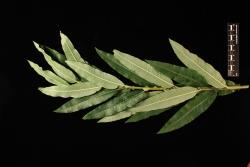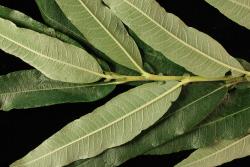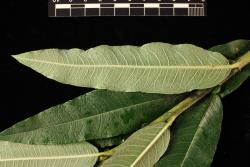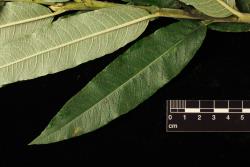- = Salix ×sericans Tausch, Flora 21: 754 (1838)
Erect, multi-stemmed shrub. Branchlet wood ridges sparse, 3–6 mm long. Current year's branchlets densely velvety, hairs persistent. Year-old branchlets glabrous to moderately densely tomentose, 3.9 mm diameter. Bud scales 5.5 mm long, 3.0 mm wide, 2.5 mm deep, without lateral angles, moderate reddish-brown (UCL43), densely tomentose. Leaves alternate. Stipule 4 mm long, narrowly ovate and falcate, persistent. Petiole 8–15 mm long, densely tomentose, glands absent, base of petiole enlarged. Emerging leaves densely velvety at first, densely tomentose on the lower surface and moderately densely tomentose on the upper surface after unfurling, hairs persisting but not to maturity, hairs silver. Proximal leaves entire. Leaf lamina 104–135 mm long, 18–30 mm wide, length to width ratio 4.0–6.2:1, narrowly elliptical to narrowly ovate, not falcate; base cuneate to rounded; apex acute; leaf galls absent; margins crenate, teeth slightly displaced to the upper surface, finely revolute; upper lamina surface slightly bullate due to impressed veins, slightly to moderately glossy, glabrous except tomentose on the midvein, stomata absent; lower lamina surface midvein and side-veins raised, indistinctly glaucous, moderately densely tomentose, hairs silver. Catkins female, emerging before leaves. Flowering branch 25–38 mm long with 4 cataphylls below catkin. Female catkin 13–23 mm long, 7 mm diameter; catkin rachis not visible between flowers. Catkins extending to 70 mm long after flowering. Flower bract 2.0 mm long, 0.75 mm wide, brown in the distal third, channelled and curved inward on the long axis; apex obtuse, silky hairs on all surfaces; female bracts persistent. Nectary 1, 0.9 mm long, 0.4 mm wide, yellow; ovary 2.0 mm long, densely short-silky hairy, exceeding flower bract; stipe 1.3 mm long, style base 0.4–0.8 mm long, style arms 0.6–1.0 mm long, unlobed, yellow-green.
Leaves are large and narrowly elliptical or slightly ovate (wider below the middle), moderately densely tomentose on both leaf surfaces in young leaves, the tomentum persisting in mature leaves. Leaf margins are crenate, on a short petiole about 9 mm long. Female catkins elongate greatly after flowering from ca. 25 mm long to 70 mm long. Dense long-silky hairs obscure the bicoloured bracts and densely hairy ovaries. The style base and style arms are long (ca. 0.7 mm each) and the style arms are unlobed. Wood ridges are short, 3–6 mm long and sparse.
Larsson (1995) is followed here over the parentage of Salix ×smithiana as S. caprea × S. viminalis. Meikle (1984, p. 118) regarded the parentage of S. ×smithiana as S. cinerea × S. viminalis. Meikle commented that the hybrids of S. viminalis with S. caprea and S. cinerea are difficult to tell apart, and that some specimens do not fit either and are probably S. caprea × S. cinerea × S. viminalis (see S. ×calodendron). Argus (2010, p. 132) similarly commented that "hybrids Salix caprea × viminalis and S. cinerea × viminalis are commonly recognised in North American floras. They are difficult to separate and their nomenclature is confusing". However, Argus followed Larsson (1995) over the parentage of the name S. ×smithiana.
Salix ×smithiana is most similar to S. ×calodendron (S. caprea × S. cinerea × S. viminalis). Both have only female plants present in New Zealand, and both have long style bases and long but unlobed style arms. Both have catkins that elongate greatly after flowering. Salix ×smithiana has narrower leaves (21–23 mm wide versus 28–57 mm wide in S. ×calodendron) that are wider below the middle when not elliptical, whereas S. ×calodendron is widest above the middle (narrowly obovate). Salix ×smithiana has a shorter petiole (8–15 mm versus 13–24 mm in S. ×calodendron). Salix ×smithiana is indistinctly glaucous on the lower leaf surface and the lower surface is obscured by dense, persistent hairs. Wood ridges are sparse and short in S. ×smithiana (dense and long in S. ×calodendron). Larsson (2000) noted that the wood ridges are shorter in S. ×smithiana than in S. ×dichroa (S. aurita × S. viminalis) or S. cinerea × S. viminalis.
In New Zealand, there are also plants, both in cultivation and in the wild, of a similar hybrid, mentioned by Meikle (1984, p. 120) under the name Salix ×ferruginea G.Anderson ex Forbes, the hybrid of S. atrocinerea and S. viminalis. This hybrid differs from S. ×smithiana in having abundant brown hairs on both leaf surfaces.
Southern North Island (Aokautere 2017), Canterbury (Kainga 1964), Otago (Cardrona Valley, "roadside scrub ... possibly a cultivation relic", 1982). PN203 in the National Willow Collection is this hybrid.
First collection: CHR 232439, A. J. Healy 64/162 & B. E. V. Parham, 1 September 1964, Kainga, Waimakariri River, Canterbury. There is no indication on the label whether the plant was found wild.
First publication: This publication.
Flowering: September.
Unknown.







